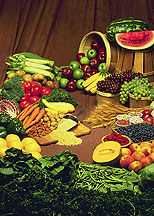 Managed by Beltsville's Research Support Services, in cooperation with the Food for Others organzation.
Managed by Beltsville's Research Support Services, in cooperation with the Food for Others organzation.
Organizations receive high-quality produce to enhance their food distribution programs.
School groups and other non-profit organizations have an educational experience and an opportunity to help the needy.
 To participate in the harvest, contact: To participate in the harvest, contact:
Your group will:
- Tour the Research Center
- Meet BARC Scientists
- Learn about BARC Research
- End the day by harvesting for the hungry.
BARC provides the fields, ice water, parking, and picking containers.
Bring comfortable clothes, gloves, shoes that can get dirty, and a hat. This is an outside activity and is weather dependent
 To receive donations of produce, contact: To receive donations of produce, contact:
- Food For Others - Pam Koch, 703-207-9173
- (Organizations must be able to provide transportation for the produce.)
 More About the Program More About the Program
Beltsville's Harvest for the Hungry was started in 1995 to recover excess produce and distribute it to needy organizations throughout the Washington, D.C. and Baltimore area.
Each year about 75,000 pounds of fruits and vegetables are harvested by church groups, schools, and other non-profit organizations.
The high-quality produce is grown in continuing support of research programs at the Beltsville Agricultural Research Center.
 Approximate Availability Dates Approximate Availability Dates
| Broccoli |
September |
| Cantaloupe |
August-September |
| Cauliflower |
September |
| Cucumber |
August-September |
| Green Bean |
late July-late September |
| Lettuce |
late May-late June, September |
| Peas |
June-September |
| Potatoes |
late June-early July |
| Spinach |
late May-late June, September |
| Summer Squash |
late July-late September |
| Sweet Corn |
late July-late September |
| Tomatoes |
late July-late September |
| Watermelon |
late August-late September |
| Winter Squash |
September |
|